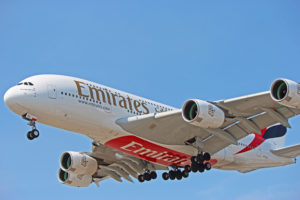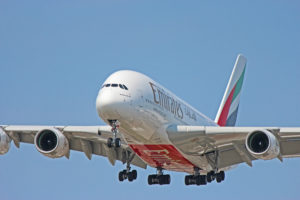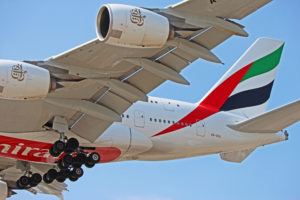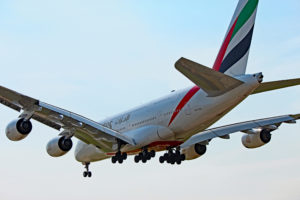 A6-EUL is an Airbus A380-800 that has only been with Emirates since December, 2016. Yet, the aircraft has had an eventful life in its first year. In its first month in service, A6-EUL inadvertently nearly caused a Bombardier Challenger 604 to crash. Later in 2016, the Airbus A380 blew a tire on takeoff from Dubai, continued its flight and landed safely in Toronto. More details on those incidents below.
A6-EUL is an Airbus A380-800 that has only been with Emirates since December, 2016. Yet, the aircraft has had an eventful life in its first year. In its first month in service, A6-EUL inadvertently nearly caused a Bombardier Challenger 604 to crash. Later in 2016, the Airbus A380 blew a tire on takeoff from Dubai, continued its flight and landed safely in Toronto. More details on those incidents below.
The images in the gallery below were taken on July 21, 2017 while plane spotting at Toronto Pearson International Airport (YYZ). For full-size, high resolution versions of any of the photos in the image gallery, simply click on the individual pictures. See below for more detailed information on A6-EUL, the Airbus A380-800 model in general and the airline.
Image Gallery
A6-EUL
Airbus A380-800
Emirates Airlines
Resources
A6-EUL Emirates Airlines Airbus A380 Image Gallery
A6-EUL
A6-EUL took its first flight on July 19, 2016 but wasn’t delivered to Emirates until December 20, 2016. The Airbus A380-800 is configured for a maximum total of 516 passengers with 14 seats in first class, 76 more in business class and 426 seats in economy class.
On January 7, 2017, the aircraft was flying from Dubai, United Arab Emirates to Sydney, Australia. Over the Arabian Sea, a business jet (D-AMSC) was flying from Male in the Maldives to Abu Dhabi, UAE. The crew of the private jet observed an Airbus A380-800 passing about 1,000 feet above them.
Shortly after, the Challenger 604 lost control in the wake of the A380. During a two minute span, the private jet was sent into an uncontrolled roll, turning the airplane 3-5 times. The engines flames out and the aircraft lost 10,000 feet before the pilots were able to recover the airplane. There were several injuries and the airplane was damaged beyond repair. However, there were other A380’s crossing the area around the same time so it remains just an assumption that A6-EUL was the cause of the turbulence.
A few months later, the airplane was flying from Dubai to Toronto, Ontario on April 17, 2017. On the initial climb out of Dubai, the crew heard a thump and received a ‘WHEEL TIRE PRESSURE LOW’ message. Tire number 10 had zero pressure and it was decided to continue to Toronto. At the destination, emergency crews were put on standby but the airplane landed safely. Along with the burst tire, there was some damage to the wheel well structure along with stiffener damage.
Airbus A380-800
The first Airbus A380-800 was introduced in October, 2007 with Singapore Airlines. There are now 213 of this type of aircraft flying with 13 airlines. The double decker airplane lands at just 48 airports worldwide. Of those, just nine are in North America and Toronto Pearson International is the only airport in Canada.
The Airbus A380-800 is 73 metres or 239 feet in length with a wingspan of 80 metres or 262 feet. At the tail, the airplane stands 24 metres or 79 feet in height. The length is just seven feet longer than the Boeing 747-400 but the wingspan is 50 feet wider. The Boeing 777-300ER is actually three feet longer than the A380. The flight range for this airliner is 15,200 kilometres.
Emirates Airlines
Based and headquartered in Dubai, United Arab Emirates, Emirates Airlines was founded and commenced operations in 1985. Owned by the government of Dubai, the airline’s main hub is the Dubai International Airport (DXB).
Emirates has a fleet of 239 aircraft flying to 140 destinations worldwide. They are the largest operator of both the Airbus A380-800 and Boeing 777-300ER. It’s go big or go home with the airline with all their aircraft either being a variant of the 777 or an A380. Starting in 2020, the airline has a massive order of Boeing 777-8 and Boeing 777-9 aircraft being delivered.




